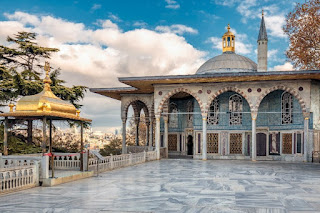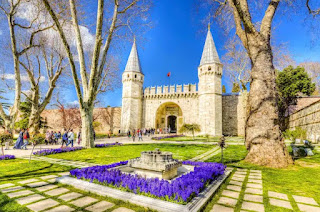Topkapi Palace
History of Topkapi Palace :
Topkapi Palace, located in Istanbul, Turkey, is a historical complex that served as the main residence of Ottoman sultans for nearly 400 years. It played a pivotal role in the governance, culture, and history of the Ottoman Empire. Here's an overview of its history:
Construction and Early Years :
Topkapi Palace was commissioned by Sultan Mehmed the Conqueror, who conquered Constantinople (modern-day Istanbul) in 1453. He ordered the construction of the palace on a hill overlooking the Bosporus Strait and the Golden Horn.
Construction began in 1459, and the palace complex was completed in stages over several decades. The palace's location allowed sultans to have a strategic view of both the sea and the city.
Ottoman Imperial Residence :
Topkapi Palace became the primary residence of Ottoman sultans from the 15th to the 19th century. It served as the administrative center of the empire, where crucial decisions were made, and state affairs were conducted.
The palace was not only a residence but also a symbol of the sultans' power and the empire's grandeur. It housed not only the sultan's family but also the court officials, concubines, and servants.
Layout and Architecture :
The palace complex consists of various courtyards, pavilions, gardens, and chambers. It was designed to accommodate the sultan's private and public life, along with the ceremonial and administrative functions of the empire.
The architecture of Topkapi Palace reflects a blend of Ottoman, Persian, and Islamic influences. It features intricate tilework, elaborate woodcarvings, and exquisite calligraphy.
Harem :
One of the most famous sections of Topkapi Palace is the Harem, where the sultan's concubines and their families resided. The Harem also included living quarters for the queen mother and the sultan's family.
The Harem was not only a residence but also a place of intrigue, political maneuvering, and cultural exchange among the diverse inhabitants.
Decline and Transformation :
As the Ottoman Empire expanded, new palaces were built, and the focus shifted from Topkapi Palace to other locations. By the 19th century, the palace's role as the center of governance diminished.
Sultan Abdülmecid I ordered the construction of the Dolmabahce Palace along the Bosporus, which eventually became the new imperial residence.
Museum and UNESCO World Heritage Site :
In 1924, following the end of the Ottoman Empire and the establishment of the Republic of Turkey, Topkapi Palace was transformed into a museum, showcasing the artifacts and treasures of the Ottoman era.
In 1985, Topkapi Palace was designated a UNESCO World Heritage Site in recognition of its historical and cultural significance.
Today, Topkapi Palace stands as a testament to the opulence, culture, and history of the Ottoman Empire. It offers visitors insights into the lives of sultans, courtiers, and the intricate workings of an empire that spanned centuries.
Attractions of Topkapi Palace:
Imperial Gate : The palace's main entrance, known as the Imperial Gate (Bab-ı Hümayun), features impressive marble columns and intricate decorative details. It serves as the gateway to the palace complex.
First Courtyard: The First Courtyard houses the palace kitchens, administrative buildings, and the imperial mint. It also contains the Hagia Irene Church, which is one of the oldest churches in Istanbul.
Second Courtyard: This area includes the Audience Chamber (Divan-ı Hümayun), where the sultan held meetings with his advisors, and the Imperial Council Chamber (Kubbealtı), where state affairs were discussed.
Third Courtyard: The heart of the palace, the Third Courtyard, contains the Harem, the private living quarters of the sultan's family, concubines, and female servants. The Harem complex is known for its intricate architecture and ornate decorations.
Fourth Courtyard: The Fourth Courtyard features the apartments of the sultan and his family, including the sultan's private chamber (Kiosk of the Baghdad Kiosk). The terrace offers stunning views of the Bosporus.
Treasury: One of the most popular attractions in Topkapi Palace, the Treasury houses an array of valuable artifacts, including the Topkapi Dagger and the Spoonmaker's Diamond.
Cultural Significance:
Ottoman Lifestyle: Topkapi Palace provides insights into the opulent lifestyle of the Ottoman sultans and their courtiers. It showcases the cultural fusion of Ottoman, Islamic, and other artistic influences.
Ceremonial Events: The palace was the site of various ceremonies, such as royal weddings, circumcision ceremonies, and diplomatic receptions, which played a crucial role in shaping Ottoman culture and diplomacy.
Islamic Art and Architecture: The intricate tilework, calligraphy, and architectural designs within the palace highlight the importance of Islamic art and culture during the Ottoman era.
Facts about Topkapi Palace:
Diverse Collection: Topkapi Palace Museum houses an extensive collection of artifacts, including manuscripts, clothing, armor, jewelry, and religious relics.
Spoonmaker's Diamond: Among the treasures in the palace's Treasury is the Spoonmaker's Diamond, one of the largest diamonds in the world. It was discovered by a street vendor who traded it for three wooden spoons, hence its name.
Historical Significance: The palace witnessed the administration and governance of the Ottoman Empire for centuries, making it a central hub for political, cultural, and social activities.
Harem Stories: The Harem section of the palace holds captivating stories of intrigue, power struggles, and the lives of the women who resided there. Some of these stories have been depicted in popular culture.
UNESCO Recognition: In 1985, Topkapi Palace was designated a UNESCO World Heritage Site for its historical and architectural significance.
Visitor Experience: Visitors to Topkapi Palace can explore its various courtyards, chambers, and museums. It's important to follow the guidelines for respectful behavior, especially in areas of religious significance.
Topkapi Palace stands as a symbol of Ottoman grandeur, offering a glimpse into the imperial lifestyle, cultural fusion, and historical richness of the empire. Its architectural beauty, valuable artifacts, and cultural significance make it a must-visit destination for those interested in exploring the history of Istanbul and the Ottoman era.






0 Comments